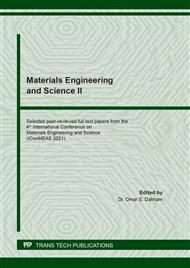p.89
p.96
p.105
p.114
p.123
p.130
p.139
p.145
p.151
Annealing Time Effect on Intermetallic Compounds of Hot Dip Galvanizing Coating
Abstract:
The use of zinc coatings deposited onto steel is one of the most important commercial processing techniques employed to protect steel components exposed to severe corrosive environments. Our objective is to improve the coated galvanizing steel used as irrigation tube in the agriculture field. After the best mechanical and chemical preparation, the substrates of this steel were galvanized by immersion in a molten zinc bath heated at 450°C during 15 min. the coated steel substrates underwent an annealing treatment in classical furnace heated at 350 °C for various holding times. This research work is to investigate the time effect of annealing treatment on intermetallic compounds of coatings obtained by hot dip galvanizing steel. For this purpose, several characterization means are used to evaluate the change effected by the annealing time on the phases of galvanizing coating. The kinetic growth of each layer relates the thickness to the annealing time by a simple power law. The treatment of annealing at temperature of 350 °C and holding time of 150 min can changed the structural and mechanical properties of coating phases. The gamma and delta layers presented the hard inner layers became relatively soft phases which would not lead to cracking and detachment of the coating.
Info:
Periodical:
Pages:
130-136
Citation:
Online since:
February 2022
Authors:
Keywords:
Price:
Сopyright:
© 2022 Trans Tech Publications Ltd. All Rights Reserved
Share:
Citation:


